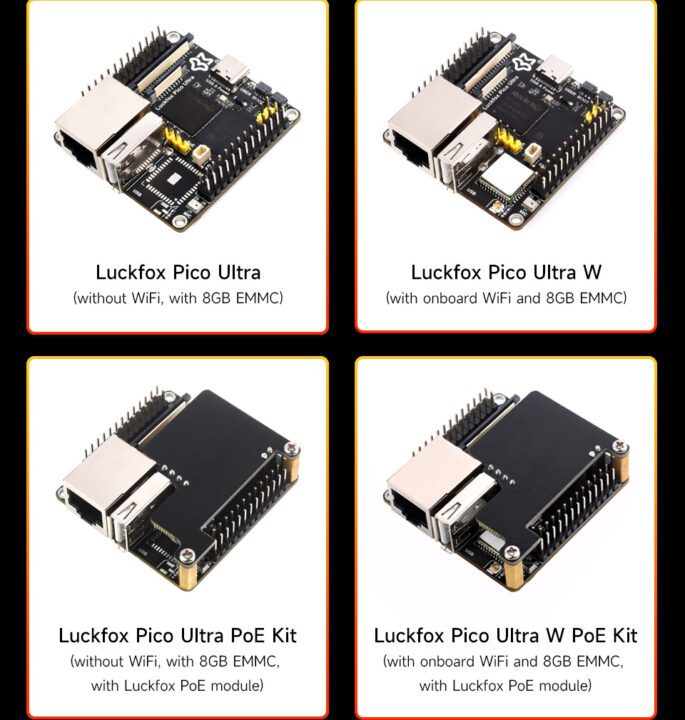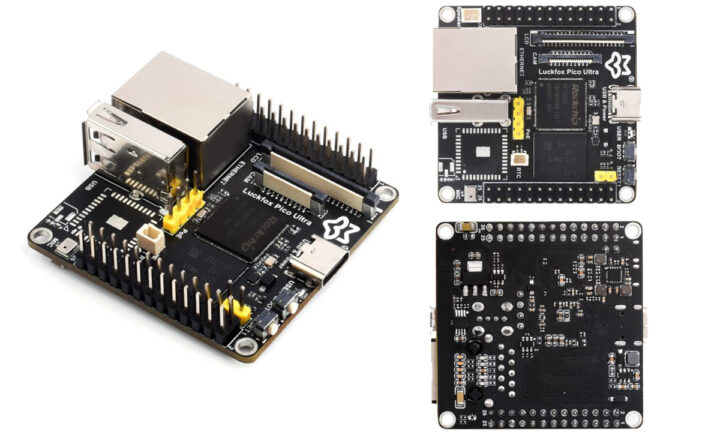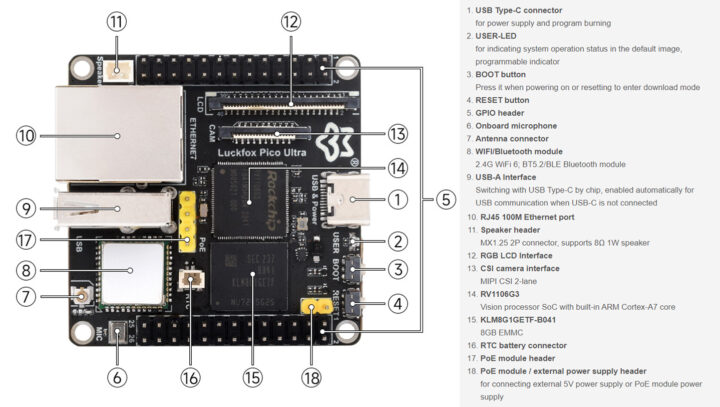The Luckfox Pico Ultra is a Rockchip RV1106-based Linux micro development board with a MIPI CSI port, an Ethernet port, and a 0.5 Tops NPU to run AI and image processing applications. Additionally, it features a speaker header, RGB LED header, GPIO, UART, SPI, I2C, USB, and much more.
Waveshare also offers a “W” version of the Pico Ultra with built-in 2.4 GHz Wi-Fi 6 and Bluetooth 5.2. If you want to add PoE support, you can connect to the board with a separate PoE module.
Luckfox Pico Ultra Specifications
- SoC – Rockchip RV1106G3
- CPU – Arm Cortex A7 @ 1.2GHz with an integrated RISC-V co-processor.
- NPU– 0.5 TOPS, supports INT4/INT8/INT16, TensorFlow/MXNet/PyTorch/Caffe/Onnx NN
- ISP – 5MP high-performance, HDR, WDR, 3DNR, 2DNR, sharpening, defogging, fisheye and gamma correction, feature detection
- VPU – 3072×1728 (5M) @ 30fps H.265/H.264 encoding, 16M @ 60FPS JPEG snapshot
- System Memory – 256MB DDR3L
- Storage – 8GB eMMC flash
- Display Interface – RGB666 LCD Interface
- Camera Interface – 2-lane MIPI CSI
- Audio – Onboard microphone, Speaker header
- Connectivity
- 10/100Mbps Ethernet controller and embedded PHY with optional PoE
- 2.4GHz WiFi 6 and Bluetooth 5.2/BLE (Available only in Luckfox Pico Ultra W)
- USB
- 1 x USB-C port
- 1 x USB-A port (Switching with USB Type-C by chip, enabled automatically for USB communication when USB-C is not connected)
- GPIO – 2x 26-pin GPIO headers
- Misc
- BOOT and RESET buttons
- User LED
- RTC battery connector
- PoE module header
- Power Supply – 5V via USB-C port or PoE port (802.3af Compatible)
- Dimensions – 50 x 50 mm
In terms of features, the board is very similar to the LuckFox Pico Pro and Pico Max which we wrote in February this year. The only difference is that the new Pico Ultra board features a different form factor and the option to add a wireless module and/or PoE support. LuckFox also offers a Rockchip RV1103 powered pico board which you can check out if you are looking for similar products.
The Rockchip RV1106G3 features the fourth-generation Rockchip NPU unit that supports int4, int8, and int16 hybrid quantization meaning that this NPU can deliver 0.5 TOPS when using int8, and 1.0 TOPS with int4. Additionally, the chip features a third-generation ISP 3.2 with support for up to 5 megapixels camera module, High Dynamic Range and Wide Dynamic Range algorithms.
In terms of software, the board supports the buildroot and Ubuntu 22.04 systems allowing developers to choose the appropriate system based on project requirements.

The Luckfox Pico Ultra comes in four different versions, so you can choose the one that best fits your needs. You can find more details about each version and other details on the Waveshare wiki page.
The Luckfox Pico Ultra deve board can be purchased on AliExpress for $26.27 and up depending on options such as WiFi and/or PoE, and it should soon become available on Waveshare Amazon store. Alternatively, you can purchase the board from Waveshare’s official store where it is sold for $17.99 to $29.99 depending on the configuration but the Waveshare price dose does not include shipping.
Debashis Das is a technical content writer and embedded engineer with over five years of experience in the industry. With expertise in Embedded C, PCB Design, and SEO optimization, he effectively blends difficult technical topics with clear communication
Support CNX Software! Donate via cryptocurrencies, become a Patron on Patreon, or purchase goods on Amazon or Aliexpress






